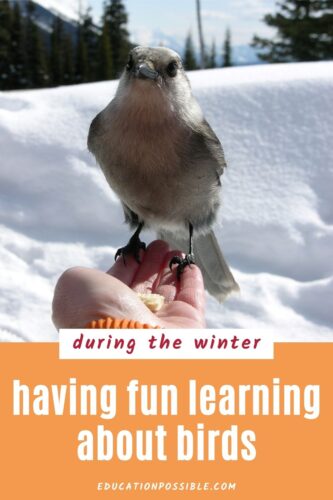Fun Winter Bird Activities for Middle School
Add these winter bird activities to your lesson plans if you’re studying birds as part of your science lessons during the colder months.
You may think it’s too cold to go bird watching, but don’t let low temperatures keep you from learning about these animals. You don’t have to wait for spring for a bird lesson.
There’s cool stuff to learn about birds in every season, especially in winter.
There are plenty of fun things you can do right now to teach your older kids about flying creatures.
From indoor birdwatching to making cold weather bird feeders, there are enough activities to keep you and your family busy during a study on birds.
Winter Bird Activities
While kids can learn about birds all year long, it’s important that you spend some time learning about birds and wintertime.
Lessons during this season can offer a unique perspective on bird behavior and seasonal adaptations.
Use these hands-on activities to round out your bird study. They’re a great snow day activity!
They include ideas for keeping your lesson on birds going even though it’s cold outside and unique things kids should learn about how life changes for these animals when the temperature drops.
Facts About Winter Birds
Every season brings opportunities and challenges to flying creatures, and winter is no different.
It may come as a surprise, but birds are well-equipped to survive some of the coldest temperatures.
They can store fat during the short days of winter to use as a built-in heater to get them through the long, wintry nights. Pretty cool, huh?
Here are a few other fun facts about birds and winter.
- Many birds can stay warm in the cold temperatures thanks to extra layers of feathers. They can fluff them up to create an insulating layer of air.
- Instead of migrating for seasons, some birds, like the Snowy Owl, live in cold climates year-round, but travel long distances to find food.
- Winter birds often survive by eating foods that are high in fat, such as nuts and seeds, which help keep their energy levels up during the colder months.
- To protect against predators while they sleep, birds will often tuck their heads underneath their wings or bury themselves in the snow.
- While a bird’s metabolism will slow down in the wintertime to help it conserve energy, it still needs to increase its food intake by 2 or 3 times to survive.
Winter Bird Observation
You probably know that one of the best things you can do when you’re learning about birds is to observe them in their natural habitat.
So it’s important to know which birds in your area stay for the colder months. While it’s true that some birds fly sound for the winter, there are many breeds that stay in place.
As far as winter migration goes, there are many reasons some birds seek warmer temperatures during the winter while others choose to hang around. The specific birds you’ll see depends on the area you live in, the overall weather, and whether your yard is bird friendly.
These are the most commonly seen birds throughout the winter:
- House Finches
- House Sparrows
- Downy Woodpeckers
- Black-Capped Chickadees
- Northern Cardinals
- American Robins
- European Starlings
Where you live, there may not be as many birds around, but with fewer leaves on the trees, kids may have a better view of the birds they see.
Birdwatching in the Wintertime
Kids should understand the basics of birdwatching in winter.
They need to remember that some species migrate, so they may not be around when it’s cold. And those that stay may be less active, but with patience, you can have an excellent bird watching experience.
It is important to keep in mind the weather and to dress appropriately when observing birds in the snow and frigid temperatures. Dress in layers and whatever else to make you comfortable.
Bring along binoculars and a field guide to help to identify the different species you see.
And as always, be respectful of their habitats.
With this in mind, let’s look at some fun things you can do to teach your kids about birds right now.
Compact Binoculars Bird Watching Field Journal
Bird Watching Field Journal North American Bird Watching for Beginners
North American Bird Watching for Beginners My Bird Watching Journal
My Bird Watching Journal
Cold Weather Bird Projects
Your older kids will appreciate the chance to put aside the textbook for a bit to work on these projects during your bird study.
Bird Feeder STEM Challenge
What tween doesn’t like a challenge? Capitalize on that by encouraging your kids to take part in a bird feeder STEM challenge.
Using recycled materials, tweens will need to figure out how to make a functional bird feeder that they can put up in the yard to help the birds endure a cold winter.
The learning continues as kids test out their design over a period of time to make sure it meets the needs of the feathered friends in your area.
They can also use this recipe to make homemade bird treats for the feeder.
Bird Observation
Kids can learn a lot when they’re observing birds, from their habitat and specific calls to individual markings and what they prefer to eat.
This full 4-6 week lesson plan will guide your tweens through the bird observation process. It provides all the background information about winter birds they’ll be observing, ideas for making connections, as well as handouts they’ll need.
Older kids will create a bird observation center in the backyard, set up bird feeders, and be on the lookout for things like:
- increase or decrease in habitat because of urbanization
- noticeable adaptations
- survival patterns
Use this observation log to help you keep track of the birds you see.

Winter Bird Art
Although this winter art lesson is geared toward elementary-aged students, the project also works for middle schoolers. Just expect their finished piece to be equal to their skill level.
To make it a bit more challenging for your kids, have them write a poem about winter birds. They can add it to the background with the birch trees.
Bird Cams
While it is important to get outside during your bird study so kids learn what birds are spending the winter in your area, you can also do some bird observation from the warmth of your home thanks to the many bird cams available online.
Bird cams give students the chance to see birds in a way they can’t do in the wild.
Here are a few to check out.
- Cornell Feederwatch Cam
- 9 live bird feeders from around the world
- These Audubon bird cams include one where you can watch Atlantic puffins
To give your tweens a well-rounded experience, include both indoor and outdoor bird watching to your lesson plan.
Jumbo Barn Owl Pellet Kit Backyard Birding Bingo
Backyard Birding Bingo National Geographic Kids Bird Guide of North America
National Geographic Kids Bird Guide of North America Bird Brains – Trivia Card Game
Bird Brains – Trivia Card Game
Bird Watching Journal
During your lesson on winter birds, have your tweens keep a journal on what they observe.
Use printable bird-themed notebooking pages or a simple spiral-bound notebook.
To get your kids started, you can give them prompts, such as birds in your area or birds in the state and have them research, write, and draw what they find in their notebook.
At the end of the season, they’ll have the start of an amazing winter bird journal.
Bird Videos for Kids
Using videos in your lesson plans will definitely keep your tweens engaged. Here are a few that your older kids will find interesting:
- How Birds Survive Winter
- Where Do Birds Go in Winter?
- How to Help Birds During Winter
- Winter Bird Feeding
After your tweens watch a few bird-related videos, let them create their own as one project in your bird unit study.
They could focus on a specific topic they’ve learned about or do a general video about the birdies they’ve seen in your area during the season.
You can also have them figure out the topic on their own and let their creativity flow.
Winter Bird WebQuest
Add this winter bird web quest to your lesson plan to help tweens learn more about how certain birds survive in the winter.
Using their computer, they’ll head over to Cornell University’s Lab of Ornithology and search for the answers to the questions found in the quest.
By the end, middle schoolers will have a better understanding of the different adaptations birds use to help them through the cold months of the season.
Bird Count
This winter, take part in an organized bird count. Not only will this be a fun activity for your bird study, it’s a great way to help the bird population.
Scientists use these events to better understand birds and come up with ways to protect them.
- The Christmas bird count takes place from December 14th to January 5th each year.
- The Great Backyard Bird Count happens in February, from the 17th to the 20th, that your family can take part in.
These are the two best known bird counting experiences, but there might be a local count going on in your area as well, so do some research to see if you can join a bird count in your neighborhood.
These counts are a fun way for kids to connect to a global event and will make them feel like they’re a part of something much bigger than their usual science lesson.

Don’t let winter stop you from studying birds. These bird activities are a wonderful way to add some fun to your science lesson plans during the colder months.
Bird Lesson Plan Ideas
If you’re looking for more things to do during your bird study, check these out.
- Printable bird watching worksheets.
- Make a nature journal while out observing birds.
- These bird projects work well any time of the year.
- Teach kids about birds with these helpful ideas.
What is your favorite winter bird activity?










